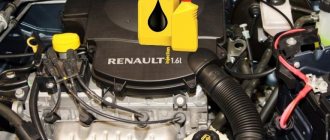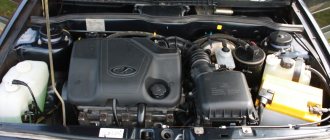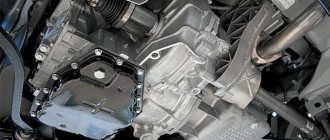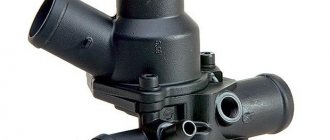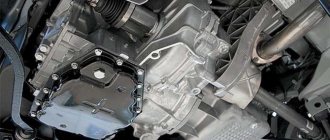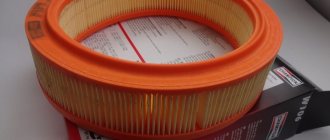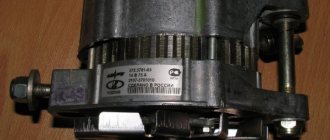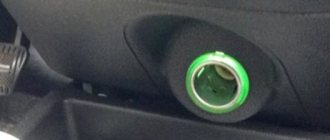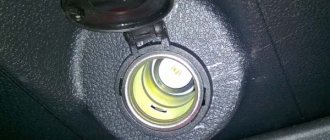August 20, 2015 Lada.Online 96 238 0
For Lada Largus, it is recommended to change the engine oil every 15,000 km. or after 1 year (whichever comes first). Under severe operating conditions (large city, very dusty area), replace the oil and filter every 7-8 thousand km.
| Engine model | Engine oil volume | Factory filled oil | Recommended oils |
| K7M (8 valve) | 3.3 liters | ELF SOLARIS RNX 5W-30 | Motor oils with quality class API SL / API SM / API SN / ACEA A1/ ACEA A2/ ACEA A3/ ACEA A5 and SAE viscosity level: 15W40; 15W50 10W40; 5W30; 5W40; 5W50; 0W30; 0W40 (depending on climatic conditions). |
| K4M (16 valve) | 4.8 liters |
When do you need to change the oil in a Lada Largus engine?
According to the replacement regulations from the manufacturer, it is necessary to change the oil in the Lada Largus engine every 15 thousand kilometers . However, taking into account the specifics of driving and operating conditions, this figure can be reduced to 10 thousand km.
To determine the need to change the oil, pay attention to signs of its depletion. The main indicator is the appearance: color change, the appearance of a burnt odor, impurities and sediment, and a decrease in lubricant thickness.
To detect these signs, regular preventative oil checks are necessary. During this procedure, the lubricant level is also measured using a dipstick. A situation in which the oil remains within the permissible range when heated and cooled is considered normal.
Despite the various processes that will begin with an excess or lack of lubrication in the system, the result will be the same - increased wear of engine components. Its consequence will be expensive repairs and replacement of entire units.
In this context, another set of signs are identified that indicate problems with the lubrication system. They are associated with engine malfunctions, jerking, and extraneous sounds.
Experts do not recommend waiting for such consequences to appear. Their presence indicates not only the need to change the engine oil, but also the demand for a full diagnosis of its components by specialists.
Maintenance schedule for internal combustion engine VAZ 11189
The manufacturer in the service book outlined the following regulations for replacing consumables:
- engine oil and corresponding filter every 15 thousand km;
- spark plugs, fuel and air filters are changed after one service;
- rivulet belt and coolant every 90 thousand km.
At each maintenance, the valves are checked and, if necessary, adjusted.
Many people advise reducing the maintenance interval to 10 thousand km and changing the oil on a warm engine. This will allow the resource of 200,000 km declared by the manufacturer to be doubled.
Tools
Of course, you will need to purchase or prepare some materials, the main ones being oil fluid and a filter. Along with them you will need:
- container for draining waste;
- hexagons, keys;
- screwdrivers;
- heads;
- rags;
- funnel;
- rubber gloves designed to protect hands.
Which oil should you choose?
The question of how to choose the right oil to replace in the engine is decided by the manufacturer’s recommendations for vehicle maintenance. For filling, the best option is the original lubricant - Elf SOLARIS RNX 5W-30. The following options are suitable alternatives:
- Shell 5W-40;
- Valvolin 5W-30;
- Gulf Formula G 5W-40;
- ZIC A+10W-40.
When choosing between mineral and synthetic oils, preference is given to the latter. Synthetics are more resistant to thermal and oxidative reactions, last longer and provide high-quality lubrication of working mechanisms.
Some car owners, however, prefer semi-synthetics for cars whose total mileage is more than 100 thousand km. This is due to the general wear and tear of parts and components, which can quickly become unusable due to synthetic lubricants.
Based on the viscosity of the oil, they are guided by seasonal temperature changes. The best options are 5W-30 and 5W-40, which are suitable for both frost and hot seasons.
Articles (must read!)
The plug is unscrewed from the bottom of the crankcase. It is supplied with a washer. These parts are not sold as a set, only individually.
Drain plug and washer
The article number of the plug is 7703075348. We were able to find three articles for the washer: 110265505R, 8200641648, 7703062062. In the latter case, it will just be a copper ring.
The washer can be made from a sheet of copper. The internal diameter should be 16.7 mm. If the dipstick is lost, it’s not a problem. Use article number 8200666287.
Selection of analogues
Firstly, the drain plug has alternative part numbers - 7703075210, 7703075347, 7903075033. Analogs for it:
- CORTECO 220100S
- BMW 07119919143
- METALCAUCHO 05655 or 00667
Show full list
- SASIC 1630210
- NISSAN 1112800Q0A or 1112800QAA
- ASAM 80102 or 30385
- CITROEN 16393 or 2221 11
- OPEL 4433916 or 4418098
- FEBI 45890
- FA1 539.970.011 or 518.471.001
The washer with a rubber band also has analogues:
- GECKO GKFLM507
- SASIC 1640540 or 4001073
- DELLO 3011020655005R
Show full list
- CITROEN 16488
- VICTORREINZ 703376900
- MANOVER MRLOGAN8853 or MRLOGAN7612
- CORTECO 006339S
- PPS 21431867
- FEBI 44793
- DT 2.10221
- AJUSA 502300
- VAICO V460562
- MERCEDES-BENZ
- SCANTECH 5321867
Filter part numbers can be found in other text.
Preparing for work
Preparing to change the oil in the Lada Largus engine involves purchasing parts and components. You will also need to choose a convenient place where you will work on the car.
When purchasing, pay attention to the quality of consumables. Along with the lubricating fluid, be sure to change the filter and drain plug gasket. If necessary, other components whose wear has reached or will soon reach a critical state must also be replaced.
You should buy new parts only from trusted suppliers and official dealers. When purchasing, pay attention to compliance with the article numbers, as well as the presence of a license and quality certificates.
After acquiring all the consumables, they proceed to preparing the work site. If possible, use a viewing hole, overpass or lift. It is also permissible to use a jack and supports to evenly lift the vehicle.
The need to observe safety precautions during work is especially emphasized. For better drainage, the engine is warmed up, however, given the heating and toxicity of the oil, there is a danger of thermal and chemical burns.
In this context, the use of protective clothing and rubber gloves is relevant. In the case of self-replacement, any things that you don’t mind getting dirty will do. You will also need a container to drain the used lubricant - it is not allowed to get into the soil.
Taking into account the recommendations presented, the necessary tools and equipment for changing the oil are included in the following list:
- overalls, lint-free rags or rags, gloves;
- set of socket wrenches, square 8;
- container for draining used lubricant with a volume of 5 liters;
- new oil, filter, rubber seals and gaskets, other parts as needed.
The final stage of preparation is warming up the engine. After this step, proceed directly to the oil change procedure.
2163-13-05a-01
Use an 8-square to loosen the drain plug.
Use an 8-square to loosen the drain plug.
Use an 8-square to loosen the drain plug.
We place a wide container for draining used oil, with a volume of at least 4 liters, and, after unscrewing the plug completely, drain the oil.
Attention! Be careful - the oil is hot.
A steel washer is installed under the plug.
Do-it-yourself oil change in the Lada Largus engine
Step-by-step instructions for changing the oil in the Lada Largus engine include the following steps:
- after the engine warms up, uncork the filler neck to speed up draining;
- in the lower part, remove the engine protection, if any, and place a container to collect the lubricant;
- uncork the drain while the oil drains - clean the plug and change the gasket;
- unscrew the filter, change the cartridge and rubber seals;
- clean and wipe the seat dry, reinstall the filter element;
- after draining the oil, clean the drain hole and tighten the plug;
- New lubricant is poured into the system, the engine is warmed up for 10-15 minutes;
- check the lubricant level and tightness of connections for leaks.
The filter can be replaced before unscrewing the drain hole - the procedure in this matter is not critical. However, to save time, the process is carried out simultaneously with draining the used lubricant.
When it comes to filling volume, they focus on a value of 5 liters. The exact value is determined in accordance with the engine size and the manufacturer's recommendations. Some people focus on the amount of liquid drained.
The best option is to fill up to 70% of the required volume and then top up with measurements of the current level. This option allows you to avoid excess or lack of oil, but you also need to take into account possible changes after the first warm-up of the engine.
The cooling system elements are checked for preventive purposes. The procedure is optional, and taking into account the frequency of replacing antifreeze, it seems to many to be completely unnecessary. However, it allows you to detect and eliminate faults in a timely manner, ensuring high-quality and reliable engine operation.
During preventive maintenance, attention is paid to the main connections of the cooling system, checked for tightness, leaks and serviceability of fasteners. The condition of the antifreeze itself is also assessed; a significant change in color and the appearance of sediment indicates the need for replacement.
Features of changing oil in 8-valve and 16-valve engines
Changing the oil in a Largus 16 valve engine is carried out according to the same scheme as in cars with 8 valves. This is due not only to the relatedness of the assemblies, but also to the standardization of the overall process.
Engine features do not affect the choice of oil; certain differences will only be in the volume of lubricant poured. 16 valves require about 5 liters, while changing the oil in a Largus 8 valve engine requires 4 liters.
There are also nuances with the location of the filter. It is easy to recognize by its cylindrical blue casing, but access to it may be limited.
In both cases, unscrewing is done by hand. If it doesn’t work, use a special tool. However, when tightening, you should not use the same tools - tighten the casing by hand, otherwise it may burst.
K4M Renault engine: characteristics, features, malfunctions
Since 1999, the Renault concern has begun producing the K4M engine, which is perhaps the most widely used among Renault gasoline engines. Installed on Renault cars: Megane, Logan, Sandero, Kangoo, Fluence, Scenic, Clio 2, Duster, Laguna, as well as on Nissan Almera G11 and Lada Largus. This power unit was created on the basis of the previous engine - K7M, but unlike its predecessor, it received 2 lightweight camshafts (respectively, 16 valves), as well as other pistons and hydraulic compensators. The engine received its further design development on Nissan cars, for which the h5M (HR16DE) engine was created.
The K4M engine has many modifications that are clearly identified by the full engine markings (numbers and letters after the engine code). For example, the motor that we sell is labeled “Renault K4MD812 engine”. This means that the power unit is equipped with phase regulators and is equipped with a manual transmission. Some motors are not equipped with phase regulators; the compression ratio and engine firmware differ. Therefore, on the market you can find K4M engines with a range of power ratings - from 102 to 115 hp.
Features of operation and resource
The main operational disadvantage of K4M engines is the relatively short service life of the timing belt. According to the manufacturer's recommendations, routine maintenance to replace the timing belt should be carried out once every 60 thousand kilometers or once every 4 years. At the same time, the cost of the spare parts required for this procedure for a 16-valve engine is quite high. Together with the timing kit, the water pump is usually replaced, although the need to replace this unit can definitely be determined only after disassembling the gas distribution mechanism drive. An interesting feature associated with the K4M engine is that the timing belt replacement schedule for Lada Largus cars is set at 120 thousand km, although the engine itself and the components are absolutely identical. In this regard, many Lada Largus owners change the timing belt kit more often than required, and vice versa - Renault owners sometimes delay this procedure, justifying this with AvtoVAZ recommendations. In any case, it is not recommended to delay this procedure, since a broken timing belt on K4M series engines clearly leads to bending of the valves and the need for major repairs.
The frequency of replacing the timing belt is more than compensated by engine life. These power units easily exceed a mileage of 400 thousand km (of course, with proper care and light operation).
Fuel consumption is approximately 8.5 liters in the combined cycle. For the highway, this figure is 6.7 liters, which is quite a bit, but in the city, the 16-valve engine can “eat up” up to 12 liters of gasoline per 100 km. By the way, K4M “digests” Russian 92-octane gasoline without any consequences, which is why it is so popular in Russia.
Typical K4M engine problems
Some of the most common K4M engine problems include:
- The motor often stalls. This is usually associated with a malfunction of the ignition coil, injector or spark plug, but it can also mean problems with the gas distribution mechanism or piston group, so it’s worth starting the diagnosis by measuring the compression.
- floating speed. A typical malfunction is most often solved by diagnosing and replacing the ignition coil or crankshaft position sensor, or with a malfunction of the K4M phase regulator.
This is probably where the list of typical K4M engine malfunctions can end, since by and large, the engine is reliable and does not cause much trouble for the owner.
www.2chance.ru
Oil change intervals
The frequency of oil changes in the Lada Largus engine is 15 thousand km. However, when making calculations, individual factors that influence the production of lubricating fluid should be taken into account:
- duration of trips around the city, frequency of stops and turns;
- aggressive driving style, high speeds;
- environment, annual and daily temperature changes;
- dustiness of roads, their surface, slipping.
All this can reduce the service life of the lubricant to 10 thousand km. In this context, regular oil checking becomes recommended. Its implementation will allow us to determine the frequency of lubricant replacement at an individual level.
The consequences of untimely oil changes are related to its functionality. In addition to lubricating mechanisms, this liquid provides heat and work product removal. Increased engine overheating will be the first consequence of its expired service life.
When heated, the working parts will begin to wear out faster, which will increase sediment and impurities in the circulating fluid. This will lead to clogging of the filter and reduce its throughput, which will cause oil starvation in the main engine components.
Further consequences depend on the total mileage of the vehicle and the service life of its components. The older the parts, the faster they will begin to fail and the larger the subsequent repairs will be.
Good luck with LS-motors
The laws of physics are inexorable - during a trip, the car is affected by vibrations, pressure, heat, friction, natural factors (water, dust, sunlight), which, of course, leads to wear and deformation of parts. Even minor malfunctions have the potential to become a serious malfunction, a hazard on the road for drivers, passengers and pedestrians.
Carry out systematic maintenance of your Lada at our station - polite staff, competent mechanics, compliance of the work with regulations, quality guarantees and extended service life of your Lada Largus car await you.
